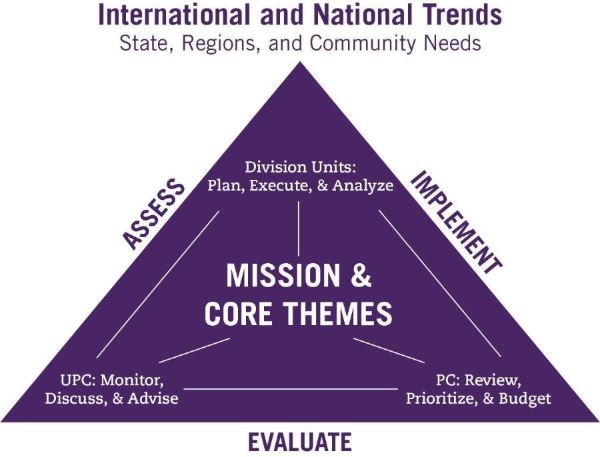WSU Planning and Budgeting Process
The planning and budgeting process has organizational and functional elements that are depicted in the graphic below.
- The planning and budgeting process is itself embedded in international and national social, economic, and historical trends that influence all aspects of higher education.
- Furthermore, there are state, regional and community needs that influence the institutional planning and budgeting process more directly due to mandates and guidance from the Governor, state Legislature, Regents, Commissioner’s Office, and Weber State’s Board of Trustees among others.

The most direct influence on the planning and budgeting process is the university mission and core themes, which ensure that the process is broad-based and coordinated. The planning and budgeting process involves three key processes, which implicate different organizational units on campus.The most direct influence on the planning and budgeting process is the university mission and core themes, which ensure that the process is coordinated while being distributed across divisions and units. The planning and budgeting process involves three key processes, which implicate different organizational units on campus.
- Assess: The process of collecting and examining data bearing on mission fulfillment and strategic initiatives that are directly derived from the mission and core themes.
- Evaluate: The process of considering strategic initiatives and making strategic adjustments designed to realize mission outcomes and funding those initiatives along with divisional needs.
- Implement: The process of realizing plans and budgets by the units within divisions.
This cycle of assessing, evaluating, and implementing the university mission and core themes is continuous and is the responsibility of two central councils. University Planning Council (UPC) performs the yearly analysis of divisional goals (Fall meeting), external scans (Winter Meeting), and mission fulfillment (Spring meeting). Composed of representatives of faculty, staff, administration, trustees, and community, these meetings fulfill the UPCs key function of monitoring, discussing and advising on mission fulfillment and the planning process itself.
From these and other inputs, President's Council (PC) meets monthly to review university capabilities and capacities, identify strategic priorities, and fund for those priorities. Divisional goals are identified given the strategic and budgetary process.
Each of the division units across the institution does the hard work of implementing divisional goals and plans in ways that make sense for the unit. Additional divisional budgeting may occur to ensure units have the resources to realize the goals and plans. The units execute the goals and plans and assess the outcomes.
